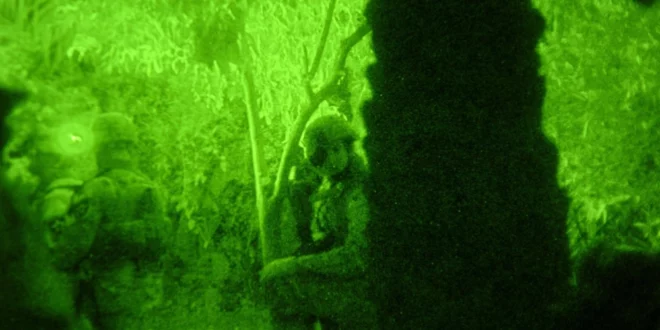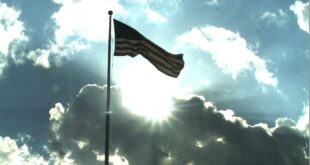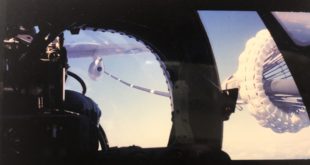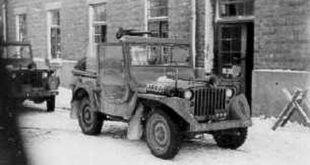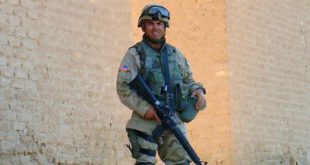by Cliff Wade
Iraq, 2007
Every now and again we’d get an outsider attached to our unit on missions. Sometimes they were enablers who proved to be assets, other times they were regarded as interlopers who got in the way. One such instance sticks out in my mind over others: the Spanish photographer from the Associated Press.
Our battalion task force had air assaulted into the city the night prior. A fleet of Chinooks disgorged hundreds of soldiers near their respective company objective areas.
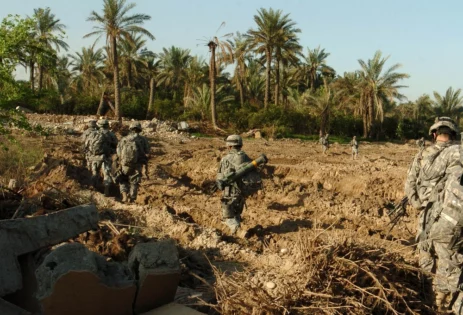
We immediately secured a date-packaging warehouse as our initial strongpoint. We were to hold that position until our mounted element of Bradley fighting vehicles and Humvees made their way to us from our forward operating base before commencing to clear the city.
While securing the warehouse, a dark silhouette popped out of a nearby palm grove. He appeared to be straining to see in the dark as he approached our company commander who was busy speaking into the hand mic of his radio. Our commander turned and began talking to the man, thinking he was one of our own. My platoon sergeant immediately muzzle stroked the man in the face with his M4, crumpling him to the ground. Our commander, confused, asked just what in the hell he was doing.
READ MORE from Cliff Wade about war in Iraq
“He’s fucking armed, sir,” came our platoon sergeant’s response while he subdued the enemy fighter on the ground, separating the man from his AK47 and zip tying his wrists.
After clearing dozens of improvised explosive devices, our mounted element arrived much later in the morning and we immediately established our company command post and began our clearing operation. I was a team leader at the time and our squad, with our platoon sergeant leading us and a squad of Iraqi Army soldiers in tow, began clearing houses towards a massive cemetery about 500 meters from our CP. A pair of Apache attack helicopters arrived on station and identified two men in the cemetery who appeared armed making their way in our direction.
The two men linked up with a third man on the edge of the cemetery who was taking cover in a densely vegetated ditch. Our commander gave the birds the green light to engage the three enemy and we held our position. The birds were flying directly overhead when they let loose a barrage of 30mm high explosive rounds. The sound was almost deafening and I initially thought we were the ones being engaged. Several of us ducked for cover. It took a moment to realize it was the sound of the Apache’s chain gun as the shell casings fell from the air all around our position.
We fell in behind one of our Bradleys and made our way to the enemy position to conduct a battle damage assessment. As we approached the cemetery a dense cloud of smoke hung in the air and the smell of the exploded rounds filled our nostrils. The pilots talked us onto the target. They identified an enemy fighter moving around in the bottom of the ditch, but we couldn’t see more than a few meters through the smoke. Our Bradley let loose several bursts from their M240C coaxial machine gun into the ditch before we approached their position on foot.
READ MORE about another soldier’s mission in Iraq
As we got closer, we found two insurgents lying at the base of a berm that ran along the edge of the ditch. Their lifeless bodies were shredded by shrapnel. The pilots informed us that an enemy was still in the bottom of the ditch, directly in front of our position. I climbed to the top of the berm and steadied my weapon on the tall grass reeds but couldn’t identify anything through the vegetation and smoke.
I considered conducting a recon by fire when the enemy fighter jumped out of the tall grass on the far side of the ditch and took off at a sprint into the smoke, heading into the nearby neighborhood. I reflexively began firing my M4 into the smoke but I lost sight of the enemy almost immediately. Pissed off at the thought of him getting away, I launched a 40mm grenade from my M203 into the cloud and saw the bright flash of the round exploding some 50 meters or so away.
My platoon sergeant, who had been standing over the dead enemy fighters had been screaming at me to get off the top of the berm while I engaged the enemy. Thinking we were being engaged, he climbed to the top of the berm and violently yanked me down behind cover. I forcefully, yet tactfully, explained that no one was shooting at us and that the enemy fighter had broken contact and was getting away.
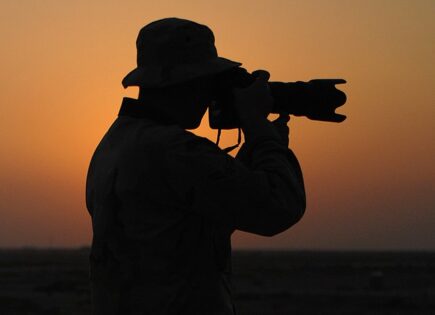
Our platoon leader was leading another squad clearing their assigned sector nearby. They were ordered to make their way to our location to attempt to interdict the fleeing insurgent. We established 360-degree security and began searching the dead enemy fighters. Their bodies were covered in wounds from head to toe. As I rolled one of the fighters over, a long line of pink colored intestines spilled out of his torso onto the ground. My camelback hose fell from my gear and the mouthpiece landed in the dead man’s guts with a soft splat. I probably went through a dozen baby wipes cleaning the sticky goo off that thing before I put it back in my mouth. By the time we were done searching them, the whole area around their bodies looked as if somebody had dropped a box full of tomatoes and then proceeded to stomp all over them. We handed off the enemies’ AK47s, magazines, and hand grenades to the very grateful IA soldiers.
The other squad found the fleet footed enemy fighter lying wounded in front of a home a few hundred meters away. We made our way to link up with them and found the AP photographer snapping photos as we established security.
As American soldiers, we have an obligation to treat wounded enemy fighters, but only after we have secured the area. There are numerous tasks that must be accomplished in the aftermath of an engagement. First, we ensured we had 360-degree security by assigning specific, interlocking sectors of fire to each soldier. Then I had to go to each of my soldiers and ensure they had enough water and that they were drinking it. Heat casualties were always an issue in Iraq.
I also had to find out how much ammunition had been expended, and retrieve any needed ammo we had stored in our Bradley, or distribute what ammo we had on hand evenly across my team. I then had to physically check my soldiers to ensure they didn’t receive any wounds in the heat of the moment and then account for all their sensitive items. I might ask what their plans were for their upcoming mid-tour leave, or ask how their favorite baseball team’s season was going. I’d offer a smoke, or a pinch of dip, just generally making sure my people were good to go, being the caring, engaged leader that I was. All these critical tasks take time, but are essential before dedicating any resources to some wounded asshole who had been trying to kill us just moments before.
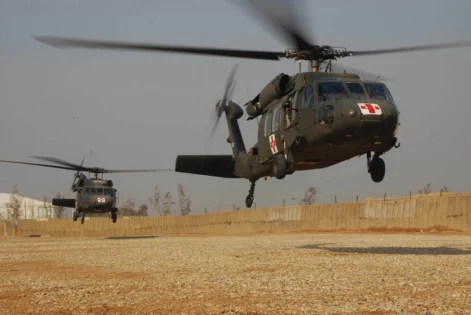
Meanwhile, the AP photographer continued to snap away with his camera while the wounded enemy lay there bleeding. As such, we curtailed our normal routine and had our medic treat the man. As Doc applied pressure bandages to his numerous wounds and a head wrap to his blood-soaked skull, our interpreter began an impromptu interrogation.
He told us his name was Mohammed and that he was 15 years old and had traveled from Saudi Arabia to join the jihad. He was incredibly lucid with us and quite articulate given his physical condition. His body was covered by shrapnel wounds and he had a nickel sized hole in the back of his head. It wasn’t uncommon to find vials of epinephrine on the enemy in our area so it came as no huge surprise that he was able to comport himself in such a manner. It was still quite impressive that he was able to run as far as he did, especially given the fact that one of his Achilles heels had been severed.
The IA were astonished, and slightly outraged, that we even bothered to treat him. To them, he was an irrhabbi dudeki that deserved to die for coming into their country to cause chaos and suffering, and to kill their (mostly Shiite) people. I would be lying if I said that, at the time, I didn’t share their sentiment. And although I can’t speak for everyone there that day, I imagine most felt the same.
Still though, we had an obligation, one that was made even more urgent under the lens of an AP photographer. We medically evacuated the enemy casualty and I found out later that surgeons removed a 5.56mm bullet from the back of his skull. That cheered me up on one hand, but made me resent the presence of the press that much more on the other. Supposedly much of the shrapnel they removed from his body was 40mm as well, though I question whether they could tell the difference between that or 30mm. Our medic assured me that the enemy fighter would be turned over to Iraqi authorities once he was stabilized and, with those wounds and the treatment he would receive, or fail to receive in an Iraqi prison, he wasn’t long for this world. That cheered me up some more.
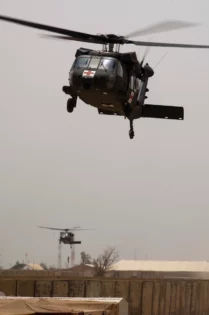
Today though, I can’t help but empathize with the teenage Saudi. He probably spent his youth learning the Wahhabi brand of Sunni Islam in some madrassa, brainwashed to believe it was his religious duty to spread the word of Allah with the sword; a paradise of virgins awaiting his martyrdom.
The only thing that intrinsically separated us, aside from a handful of years in age and our immensely divergent religious views, was the fact that I was born within the boundaries of my country’s arbitrary border lines, and he in his. And while our circuitous paths took vastly different trajectories that led us to meet that day, I must acknowledge that had I been in his shoes, I too, almost surely, would have found my way to Mesopotamia with the same verve and vigor to slay infidel invaders in the name of God. We were, in a way, kindred spirits; two young men willing to kill for a cause. We had that in common, and in some perverse way, I feel a level of kinship with him more than I do with my own countrymen of fighting age who stayed home during the war. But, as it were, he was my enemy and my side won out that day. I’ve never lost any sleep over it.
Perhaps I would feel differently if the photographer hadn’t been there, and the young Saudi didn’t get the treatment to stabilize him in a timely manner, leading to his death right there on the battlefield instead. Maybe I’d be saddled with guilt today. Perhaps I owe that photographer a debt of gratitude. Considering the young enemy fighter probably ended up dying anyway, I kind of doubt it.
Cliff Wade previously wrote for Soldier of Fortune about being inside the home of an Iraqi family during a massive clearing operation.
 Soldier of Fortune Magazine The Journal of Professional Adventurers
Soldier of Fortune Magazine The Journal of Professional Adventurers


